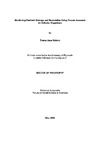Monitoring Peatland Damage and Restoration Using Testate Amoebae as Indicator Organisms
| dc.contributor.author | Vickery, Emma Jane | |
| dc.contributor.other | School of Geography, Earth and Environmental Sciences | en_US |
| dc.date.accessioned | 2013-10-24T09:32:46Z | |
| dc.date.available | 2013-10-24T09:32:46Z | |
| dc.date.issued | 2006 | |
| dc.date.issued | 2005 | |
| dc.date.issued | 2006 | |
| dc.date.issued | 2005 | |
| dc.identifier | NOT AVAILABLE | en_US |
| dc.identifier.uri | http://hdl.handle.net/10026.1/2338 | |
| dc.description | Merged with duplicate record 10026.1/862 on 22.03.2017 by CS (TIS) | |
| dc.description.abstract |
This thesis has examined the response of testate amoebae communities to restoration at three peatland sites in the UK. It builds upon the use of testate amoebae analysis as a palaeoenvironmental tool by exploring the hypothesis that testate amoebae respond to hydrological conditions in restored mires. Previous research has found that testate amoebae act as good proxies for hydrological condition of intact mires and past conditions but little has been done on their reaction to conditions at damaged sites in the UK. The research aimed to further the understanding of testate amoebae ecology including seasonal variability of communities, a poorly understood area. The secondary aim was to assess the potential for using testate amoebae as biological indicators of peatland damage and restoration. These aims were achieved through studies at three sites covering a range of damage commonly affecting UK sites. The experiments entailed repeated monitoring of a ditch blocking experiment at Coom Rigg Moss which has been affected by peripheral forestry drains, a study of forest removal treatments at Flanders Moss and a study of rewetted cutover surfaces at Fenn's and Whixall Mosses. The results were analysed using a variety of statistical and multivariate methods. Data on water table and moisture conditions were also analysed and the results of the two were compared. The results showed that testate amoebae communities responded to hydrological conditions but depth to water table was not always the primary factor affecting community composition. The results of the research indicate that testate amoebae analysis does have potential as a tool for monitoring peatland restoration but further research is necessary to fully understand the factors affecting distributions. | en_US |
| dc.language.iso | en | en_US |
| dc.publisher | University of Plymouth | en_US |
| dc.title | Monitoring Peatland Damage and Restoration Using Testate Amoebae as Indicator Organisms | en_US |
| dc.type | Thesis | |
| dc.identifier.doi | http://dx.doi.org/10.24382/3837 |
Files in this item
This item appears in the following Collection(s)
-
01 Research Theses Main Collection
Research Theses Main


